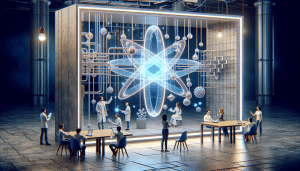Why Artificial Intelligence Is Reshaping Your Digital World
Aiden Foster September 29, 2025
Explore how artificial intelligence is quietly transforming everyday life. From smarter virtual assistants to new scientific breakthroughs, the impact of AI technologies stretches far beyond what most realize. This guide explains where AI is headed, what it means for careers, and the ethical questions shaping its future.
Understanding AI and Its Everyday Presence
Artificial intelligence, commonly called AI, is no longer a concept reserved for sci-fi films or advanced laboratories. It is woven into the digital thread of daily life, guiding everything from ride-sharing apps to virtual classroom tools. AI uses algorithms and vast data streams to recognize patterns, answer questions, and anticipate needs. Think of the gentle voice of a digital assistant suggesting reminders or the personalized recommendations that appear on your favorite streaming platform. These moments reflect machine learning and natural language processing technologies, which work together to refine the online experiences of millions each day. AI’s presence feels subtle but is becoming indispensable for seamless digital interactions.
The journey of AI into mainstream use has been fueled by enormous growth in data availability and improved computing power. As more devices connect to the internet, the opportunities for AI to collect information and learn from real-world choices multiply. This constant flow of information lets systems adapt quickly, whether it’s a navigation app rerouting traffic or a health tracker alerting about unusual activity. Familiar gadgets, from smartphones to smart refrigerators, increasingly rely on embedded AI software to process input, provide predictive suggestions, and adapt to users’ habits automatically. The blend of convenience, efficiency, and automation makes AI almost invisible—yet it powers many of today’s digital surprises.
For most consumers, artificial intelligence runs quietly behind the scenes. Yet, the implications stretch well beyond gadgetry: businesses now harness AI-driven analytics to tailor products, optimize supply chains, and enhance customer engagement. Healthcare professionals employ advanced diagnostic tools powered by AI models, while educators use smart platforms to customize lesson plans. As AI continues expanding, it’s becoming a universal tool, quietly shaping life at home, at work, and even in recreational activities. Understanding its ubiquitous role is crucial for recognizing how deeply integrated it is in modern society.
The Science Behind AI: From Algorithms to Deep Learning
At its core, AI is built upon mathematical models and algorithms. These sets of rules tell machines how to learn from patterns and make decisions. Machine learning—a subfield of AI—relies on training computers with large sets of examples. Over time, the system identifies relationships and draws conclusions from new information. Deep learning, an advanced branch of machine learning, uses artificial neural networks modeled loosely on the human brain to solve complex tasks such as image recognition or language translation. With every iteration, these models become more adept at tackling sophisticated problems, bridging the gap between human and machine intelligence.
The science extends to data collection and data labeling, two essential components that drive AI’s reliability. For example, to train an AI to identify certain diseases from X-ray images, researchers annotate thousands of images with the correct diagnosis. The AI then learns to spot subtle cues within new images, improving accuracy with more exposure. Progress in computing hardware also factors into AI’s expanding capabilities. Specialized chips known as GPUs (graphics processing units) now allow even standard laptops to run machine learning models that previously required supercomputers, helping AI reach a broader audience across various industries.
What separates advanced artificial intelligence from traditional automation is adaptability. Early computer programs followed rigid instructions, executing tasks in predictable patterns. Today’s AI dynamically adapts as it receives new data. For instance, self-driving vehicles continuously analyze a stream of sensor, camera, and radar input, recalculating safe driving paths in real time. This scientific leap is setting the foundation for further breakthroughs, where AI will continue developing new strategies, learning independently, and interacting with the world in increasingly sophisticated ways.
AI in the Workplace and the Changing Nature of Careers
Work environments have felt a profound shift due to the influx of artificial intelligence solutions. AI-powered automation handles many routine business processes, from sorting resumes in human resources to detecting unusual network activity in cybersecurity. In manufacturing, robots with AI vision systems streamline tasks like assembly and inspection. Meanwhile, smart software boosts productivity in customer support by quickly categorizing queries and suggesting resolutions. AI also powers data analytics engines that help executives make decisions based on forecasted trends, rather than relying solely on past performance or gut instinct. Entire industries, including finance, logistics, and healthcare, now depend on AI for accuracy, scale, and speed.
This increased reliance on AI is changing the skills employers prioritize. Technical literacy is valuable, but so are creative skills, critical thinking, and adaptability. Many jobs now require workers to collaborate effectively with intelligent machines or manage AI-driven platforms. New roles are emerging as well, such as data curators and AI ethicists, who ensure that models are trained on accurate, representative datasets and that algorithmic decisions remain transparent. For employees, upskilling and exploring free online courses in data science and AI principles can create pathways to future-ready roles and improved job security (Source: https://www.coursera.org/articles/ai-careers).
Challenges remain for those navigating the evolving workplace. Some positions face risk of automation, while others benefit from job creation in new sectors. Organizations are increasingly investing in workforce retraining and ongoing digital education to maintain a balance between human innovation and machine efficiency. As AI advances, finding ways to harmonize technology with the unique capabilities of human workers will become even more important for sustainable, inclusive progress.
Ethical Considerations and Responsible AI Development
AI brings remarkable promise, but it also raises critical ethical and social issues. One central concern is algorithmic bias. If an AI is trained on data that reflects past inequalities, it may inadvertently reinforce those patterns when making decisions. For example, facial recognition systems have sometimes displayed lower accuracy for people of color, sparking calls for more equitable training data and ongoing performance audits (Source: https://www.brookings.edu/articles/algorithmic-bias-detection-and-mitigation-best-practices-and-policies-to-reduce-consumer-harms/).
Transparency and accountability are fundamental to building public trust in AI. Policymakers, tech companies, and nonprofit organizations have begun developing ethical frameworks and guidelines for responsible AI development. These include recommendations for transparency in algorithmic decision-making and the right to explanation when automated systems deny access to services. Beyond compliance, some organizations champion “explainable AI”—systems that can clarify why they reached a given result. These practices help ensure fairness, protect personal rights, and support responsible innovation (Source: https://www.oecd.org/going-digital/ai/principles/).
Privacy is another pressing issue. AI applications in fields such as health and finance may process sensitive personal information. This has led to the formulation of strict data protection regulations in various regions. Advanced encryption methods, data minimization strategies, and user consent models are now integral elements of modern AI deployment. Together, these measures create a framework that helps balance progress with the protection of individual rights (Source: https://www.edx.org/learn/ai-ethics).
AI’s Role in Accelerating Scientific Discovery
Scientific research now depends on artificial intelligence to boost both speed and accuracy. AI algorithms mine vast data sets for insights, revealing trends previously buried in complex spreadsheets or physical records. In genomics, machine learning models help pinpoint genetic variants linked to diseases, dramatically accelerating drug discovery and the development of targeted therapies. Similarly, climate scientists employ AI to model shifting weather patterns, improving the precision of long-term forecasts and disaster planning (Source: https://ai.nih.gov/).
In astronomy, AI sifts through massive volumes of telescope data, identifying new planets and mapping distant galaxies at a pace beyond human capability. Physics researchers deploy deep learning to recognize particle interactions in collider experiments, while chemists simulate molecular interactions to design greener materials. AI brings scale to these explorations, democratizing access to powerful analytics for academic and citizen science projects alike. This collaborative power between humans and technology opens doors to even more ambitious research questions.
AI also acts as a catalyst for interdisciplinary partnership. Machine learning tools allow experts in different domains—biology, physics, computer science, and beyond—to share knowledge and resources. For instance, artificial intelligence assists doctors and researchers in making faster, more accurate diagnoses by correlating symptoms, lab results, and population data in real time. As the capabilities of these tools expand, their influence will continue to broaden across the research landscape, promising innovation at an unprecedented scale.
Everyday Benefits and Future Possibilities for Users
Most people interact with artificial intelligence without realizing it. Navigation apps that avoid traffic, language translation platforms, automatic spam filtering, and even e-commerce chatbots all rely on AI’s adaptable logic. These services streamline daily routines, reduce friction, and provide personalized experiences. They demonstrate how AI is not just about exotic robotics; it’s a practical tool enhancing everything from entertainment recommendations to fitness tracking and beyond.
Looking forward, the capabilities of AI are set to expand even further. Smart home systems will become more intuitive, seamlessly adjusting lighting, heating, or security settings based on learned preferences. In education, AI-driven platforms will continue to identify individual learning gaps and adjust content to maximize student success. Meanwhile, in finance, AI models are expected to play greater roles in fraud detection and personalized budgeting tools, supporting greater financial health for users (Source: https://www.pewresearch.org/internet/2022/06/21/experts-say-the-rise-of-ai-will-make-most-people-better-off-over-the-next-decade/).
Still, society will need to carefully manage the balance between innovation and privacy, automation and employment, as AI’s reach continues. Preparing for these changes—by learning about new technologies and participating in ongoing discussions of their ethical implications—empowers people to make the most of what artificial intelligence offers. The journey is just beginning. AI opens more possible futures with each technological stride.
References
1. Brookings Institution. (n.d.). Algorithmic bias detection and mitigation: Best practices and policies to reduce consumer harms. Retrieved from https://www.brookings.edu/articles/algorithmic-bias-detection-and-mitigation-best-practices-and-policies-to-reduce-consumer-harms/
2. OECD. (n.d.). OECD AI Principles. Retrieved from https://www.oecd.org/going-digital/ai/principles/
3. edX. (n.d.). AI Ethics courses. Retrieved from https://www.edx.org/learn/ai-ethics
4. National Institutes of Health. (n.d.). AI at NIH. Retrieved from https://ai.nih.gov/
5. Coursera. (n.d.). AI Careers Guide. Retrieved from https://www.coursera.org/articles/ai-careers
6. Pew Research Center. (n.d.). Experts say the rise of AI will make most people better off over the next decade. Retrieved from https://www.pewresearch.org/internet/2022/06/21/experts-say-the-rise-of-ai-will-make-most-people-better-off-over-the-next-decade/








